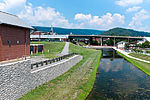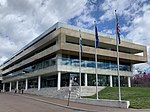Tidewater Lock
Chesapeake and Ohio CanalDams in Washington, D.C.Georgetown (Washington, D.C.)Publicly owned dams

The Tidewater Lock is a dam in Washington, D.C. to the west of the mouth of Rock Creek at the Potomac River, on the east side of Georgetown. Built to connect the Chesapeake and Ohio Canal, opened in 1831, with the Potomac, it was a busy maritime intersection during several decades of the canal's heyday. C&O documents refer to it variously as Lock 0 and Tide Lock A. Canal documents sometimes list a "Tide Lock B" on section "I" which stood at the lockhouse at 17th and Constitution Ave NW. It was completed in 1834.Today, the lock marks Milestone 0 of the National Park Service's Chesapeake & Ohio Canal trail.
Excerpt from the Wikipedia article Tidewater Lock (License: CC BY-SA 3.0, Authors, Images).Tidewater Lock
Rock Creek Trail, Washington Foggy Bottom
Geographical coordinates (GPS) Address Nearby Places Show on map
Geographical coordinates (GPS)
| Latitude | Longitude |
|---|---|
| N 38.8999 ° | E -77.0578 ° |
Address
Lock 0 (Tidewater Lock)
Rock Creek Trail
20566 Washington, Foggy Bottom
District of Columbia, United States
Open on Google Maps









